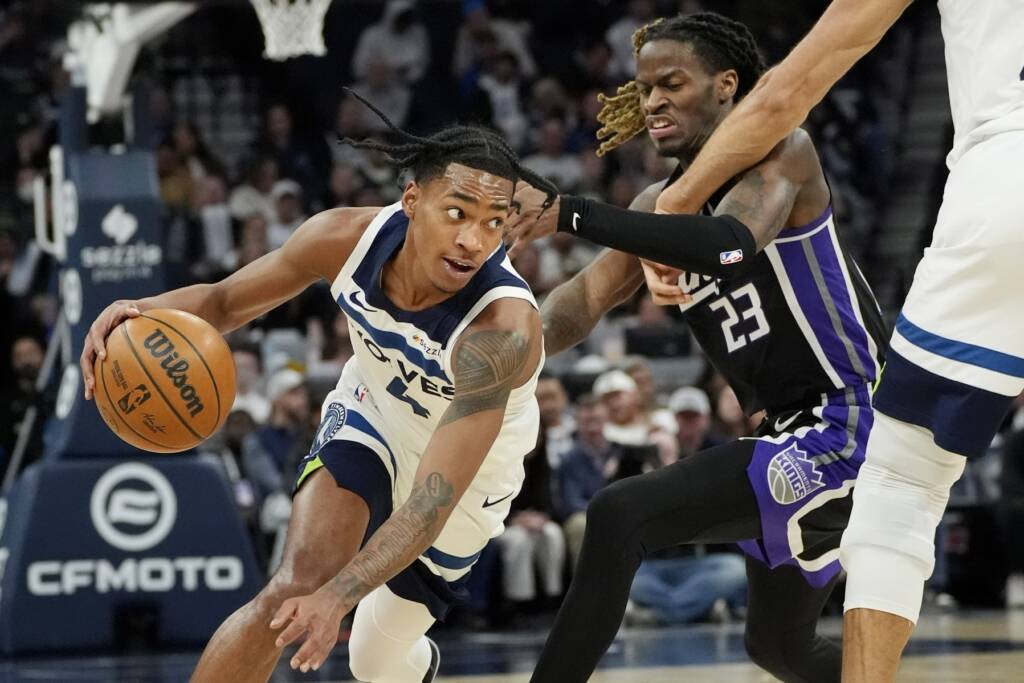The Minnesota Timberwolves have demonstrated their intent to retain their core next season by re-signing Julius Randle and Naz Reid to extensions before the free-agency signing period opened. Still, Minnesota’s roster will look different next year.
The Wolves lost Nickeil Alexander-Walker, a core rotational player, to the Atlanta Hawks. They also lost fringe rotational pieces Josh Minott and Luka Garza to the Boston Celtics.
There are easy pathways to map out the replacements for Alexander-Walker, but it’s more intriguing with Minott and Garza. Neither player had a huge role for the Timberwolves, and Minnesota should be able to find replacements with whom they’d feel more comfortable playing more often.
Unless the Wolves wanted to enter the second apron and face roster-building restrictions, Alexander-Walker was bound to depart once the Timberwolves re-signed Randle and Reid.
Luka Garza worked hard to transform his body and earn NBA minutes. Still, it would have been hard for him to earn a long-term role. Garza has significant defensive shortcomings, and the Timberwolves have a strong frontcourt of Randle, Reid, and Rudy Gobert, who they’ve locked in for the future. They also added two international big men, Joan Beringer and Rocco Zikarsky, in the draft.
According to The Athletic’s Jon Krawczynski, Minott asked the Timberwolves to decline his team option and allow him to find an opportunity for real minutes elsewhere.
Minott had limited opportunity with the Timberwolves. He only played in 93 games in three seasons, and he mostly played in garbage time. For Minott to develop in Minnesota, he would need more freedom to play through his mistakes and learn from them. Unfortunately for Minott, the Wolves are in win-now mode, and that’s not how Chris Finch typically operates.
With all of the off-season movement out of the way, it’s easier now to forecast how Rob Dillingham, Terrence Shannon Jr., and Jaylen Clark can fill the voids left in the rotation. Given that the Wolves used the eighth overall pick on Dillingham and played Shannon and Clark in contested games last year, it looked like they wanted to give them more opportunities this year.
The Timberwolves traded two future first-round picks to move up for Dillingham in the 2024 draft. Therefore, it would only make sense for them to give him a bigger role next year. Mike Conley is entering his age-38 season and is coming off a career low in points, minutes per game, and 2-point field goal percentage. Not only does Minnesota’s guard room need plans moving forward, but they also need a spark now.
Dillingham’s shot creation potential and on-ball creativity are something the Timberwolves desperately need in the rotation. Dillingham may have some growing pains, but the Wolves should give him an open opportunity to work through his struggles as a smaller young guard.
Shannon had flashes throughout the season. He only played in 32 games, but he had a 25-point game against the Los Angeles Lakers, and 17-point games against the Oklahoma City Thunder and Utah Jazz. Shannon also looked comfortable in his limited playoff minutes in the Western Conference Finals against Oklahoma City.
Finally, Jaylen Clark was a surprise impact player for the Timberwolves. Despite recovering from an Achilles tear he suffered at UCLA, Clark played 14.3 minutes per game in Minnesota’s final 36 games of the season. He brought low-usage offense, with impactful effort and defense.
Third-year big Leonard Miller will likely take over Garza and Minott’s spot on the depth chart.
Miller is a difficult player to project because he has never played real rotational minutes in a regular-season game. All of his minutes have been with the Iowa Wolves or in blowouts. Miller has only played 30 games and 84 minutes in his young career.
He was also a late-blooming prospect. Miller burst onto the recruiting scene late and played one year for the now-defunct G-League Ignite. He will only be 22 this upcoming season, but the Timberwolves could use his modern tools in the Garza-Minott role. His ball-handling upside, size, and potential to stretch the floor as a shooter are all tantalizing.
It’s impossible to know how Miller would fare in rotational minutes. However, soon enough, he should at least earn the spot minutes that Garza and Minott did when others were injured or resting.
Ultimately, the Timberwolves appear to be entering a year of retooling and growth. Much of the core is back, although there is still much to consider for the team’s next era. They are fresh off back-to-back Western Conference Finals appearances. Still, Conley and Gobert’s aging curve, in addition to the need to see what the younger assets can bring, may just hold the Timberwolves back a bit this season.
The next era is easy to envision, with Anthony Edwards, Jaden McDaniels, and Reid taking prominent roles. Three players are around the same age and have played their entire careers alongside each other in the organization. Building around two timelines is difficult, but working in between is the key to success.
If the Timberwolves want to stay competitive while still building for the future, finding the balance between playing the younger players alongside the established players will be crucial. Finch has typically leaned on his veterans, but he’ll have to incorporate Minnesota’s young players to build on their success next year.

